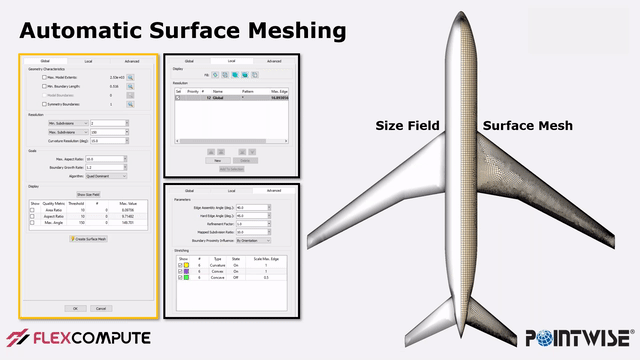Mesh and Run a High-Fidelity Aircraft Simulation in Minutes

Intelligent automatic meshing meets super solver speed for unrivaled CFD efficiency.
Watch a webinar that will help boost productivity while simultaneously ensuring mesh consistency and reliability across your organization. Increasingly complex geometry, larger simulations, and design optimization are just a few characteristics of advanced simulation and design that emphasize the need for more automation and higher throughput. Yet, automation in the absence of control and expertise often has limited applicability, including the inability to maintain consistency throughout the design and simulation process. This can result in an inaccurate, and sometimes unreliable, understanding of a design or the design space, slowing the turn-around time and delaying time to market.
With this in mind, at Pointwise we have been developing a new suite of features called Flashpoint that take the control and expertise we are known for and combines them with deeper automation. Flashpoint, and in particular, the automatic surface meshing component, will help ensure consistency and reliability throughout the meshing process while also providing a framework for encapsulating your organization’s best practices. We recently collaborated with FlexCompute, the developers of Flow360, a new cloud-based CFD solver, and using the NASA Common Research model as our benchmark, we are demonstrating the ability to mesh and run a high-fidelity aircraft simulation in minutes.
Overview
- Automatically generate a high-quality surface mesh for an aircraft geometry
- Construct and populate a hybrid-viscous, hex-core volume mesh in minutes
- Reduce turnaround time and setup, deploy, and simulate using Flow360
- A quad-dominant surface mesh and hex-core volume generated using Pointwise. Solution computed using Flow360 CFD.
A quad-dominant surface mesh and hex-core volume were generated for NASA’s Common Research Model using Pointwise’s latest automatic surface meshing and voxel meshing capabilities. The solution was then computed using FlexCompute’s Flow360 CFD solver with a runtime of just 105 seconds.
Presenters
Travis Carrigan joined Pointwise as a senior engineer after completing his M.S. in aerospace engineering at The University of Texas at Arlington in May 2011 where his graduate research involved aerodynamic design optimization and GPU-based computing. As Manager of Business Development, Mr. Carrigan works with clients and software partners to demonstrate best practices in grid generation and develop interactive and automated meshing solutions using Pointwise.
Feilin Jia is a research scientist in the team of computational fluid dynamics of FlexCompute Inc. He is passionate about developing high-performance numerical algorithms of computational fluid dynamics on big clusters as well as conducting simulations on new models for verification and validation. Before joining FlexCompute Inc, he obtained a Ph.D. degree in aerospace engineering at the University of Kansas in 2019. During his Ph.D. period, he pioneered the work of high-order large eddy simulation, one of the most advanced CFD technologies in the world.
Qiqi Wang is a co-founder and the lead of computational fluid dynamics of FlexCompute Inc. He and his team members focus on the research and development of computational fluid dynamics algorithms on next-generation computational hardware. He is also an Associate Professor in the department of aeronautics and astronautics at Massachusetts Institute of Technology where he has been a faculty member since 2009. His current research interests include simulation, design and optimization of aerospace vehicles using advanced computational algorithms and machine learning. Before joining MIT, he obtained a Ph.D. degree in computational and mathematical engineering (major) and aeronautics and astronautics (minor) from Stanford University. He is an associate fellow of American Institute of Aeronautics and Astronautics.